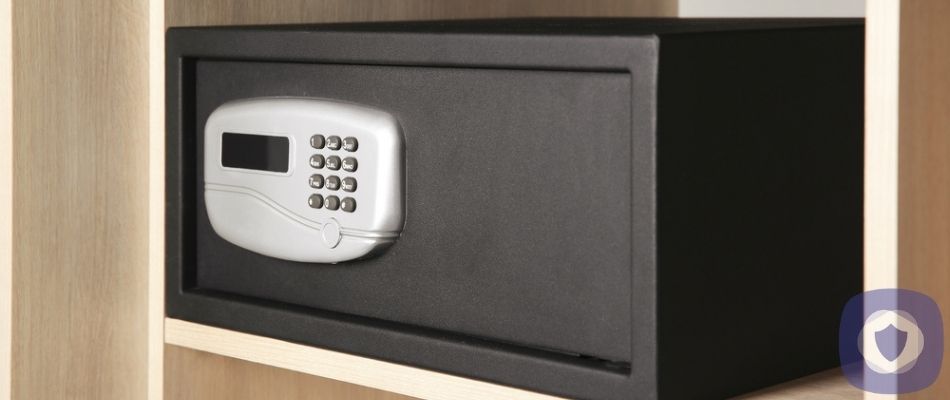Millions of homeowners rely on a home safe to keep their important documents, jewelry, and emergency cash safe. But the security of your valuables is impacted by where you store them – leaving a safe in a prominent location could lead a burglar to it easier.
Things to consider
Hiding your safe does have some negatives; if you hide it too well, it can become a case of ‘‘out of sight, out of mind’’ and you may end up hoarding valuables in the back of a drawer intending to move them to your safe later and never getting around to it. Your precious items may also wind up damaged by dampness, neglect, or other issues if you hide them in the wrong place and forget about them. Some safes are also small enough to pick up and run away with (such as the book safes) or weak enough to pry open with a crowbar.
There’s nothing wrong with relying on a small safe such as a book with a hidden compartment for your bookshelf, and most burglars won’t think to tear apart dictionaries or Bibles. But do have a good think about whether hiding your safe will keep your valuables safer – most burglars don’t have the means to attack a home safe as long as it’s too large and well-anchored to steal. But if you’ve decided to hide your home safe, read on. We’ve compiled a list of some of the most secure places to hide your home safe.
Old fridge
It’s common to have a second fridge in the garage or basement for surplus beverages, and thieves are unlikely to poke around for valuables. You can place your safe in a bag and stow it in a freezer compartment; this works best for smaller safes. You can also invest in a freezer door lock. This isn’t a high-tech option, but it’s a good DIY option that allows you to hide in plain sight.
Air vents
Another good shout for smaller safes is a vent, but did you know you can actually get vent safes? Designed to look exactly like a genuine vent, these safes can be mounted to a wall in under 10 minutes and open with an RFID card or key fob. The only negative thing about this type of safe is that it wouldn’t stand up to much of a beating if burglars did find it. Still, it’s unlikely to set off alarm bells as long as it’s installed somewhere that you’d expect to find a vent.
Under the floor
Unless you have a loose floorboard or good woodworking skills, you may want to hire a professional to assist with this. If you cut out a small area of your flooring (in an area with no plumbing or wiring, naturally), preserving the cut out for use as a lid, you can then build a wooden box for your safe and anchor the box to the floor joists using screws. A piece of furniture or rug will complete this hiding spot perfectly.
Pet food safe
Another diversion safe uses the cover of pet food to keep your valuables safe. This is only really a good safe if you have pets, though, as otherwise, it may look suspicious. You can get keypad entry stainless steel safes that look like dog food boxes. Some options include bolts that allow you to mount the safe to the floor, wall, or shelf to prevent it from being stolen, but it’s hard to believe thieves would even glance twice at pet food.
Furniture
You could hide a safe in built-in furniture storage or any furniture. A common place is a wardrobe or closet. But an often-overlooked spot is the bed. While it may seem cliché (hiding your money under the mattress), modern beds’ trendy upholstered faux leather beds come with under-mattress storage that makes it easy to put a safe in. You could even drill it in to secure it. Another option is to find a bed with a built-in safe.
A wall safe
A wall-mounted safe can be pried-free with the right tools, but one that’s embedded in the wall is far harder to pry out. Most mount flush between the studs, and you can conceal it in the closet or even in a hallway behind artwork or a mirror. You’ll need professional installation to ensure it sits correctly and not all walls are designed to take safes, but it’s one of the better options for a hidden safe.
Book safe
Book safes are quite common, most often disguised as a dictionary or Bible. They’re not high-tech and vulnerable to theft, but if you hide them in your bookcase, they may go undetected. It’s also not ideal for holding much, but you can usually put your passports, documents, and a little cash in them. I’d hesitate to trust them with anything of significant value, though.
In your staircase
You can design under stairs storage and create a sizeable secret hiding place for a secure safe. After removing the stair tread, you can slip your safe into the step and re-attach it with a piano hinge so you can lower or lift the tread. If you’re good at woodworking, you may consider removing the riser. You could consult a professional for this option. Either way, a burglar won’t think to check the stairs.
Further from the previous idea, you can also take it a step further by installing a door or drawer in the opening and stowing your safe inside them. This creates somewhat of a mini-crawl space that you could even use in the event of an emergency – like a break-in.
Beneath kitchen cabinets
Depending on the type of kitchen cabinet you have, it may be possible to remove your kickboards then replace them, allowing you access to put a safe inside. Your kickboards can serve as a hidden door, of sorts. Obviously, you wouldn’t be able to use a large safe, but a small to medium safe is possible depending on your kitchen layout.
Secret shelves
You can buy shelves with secret compartments designed to house valuables for you. The QuickShelf safe by Quicksafe is a good example, comprising of a 24-inch birch shelf with a built-in compartment (unlockable with RFID keys), but there are many similar products on the market.
Fireplace/mantle
You can hide your safe behind the mantel trim or in the back of the (disused) fireplace. Many fireplaces these days go unused, or they’re not up to par with regulations, that doesn’t mean it can’t make for an interesting hiding place for your safe.
Decoy safe
Similar to the concept of a diversion safe mentioned earlier, you could also rely on a decoy safe. A small-to-medium safe in a more ”obvious” location such as a master bedroom, living area, or garage will mean that thieves spend more time trying to get into that than searching for the ”real” safe, which will be more secure and hidden somewhere far less obvious. In the event of a break-in where you’re present and are asked for the code, you can also give access to the first safe, giving the impression of compliance while your hidden safe is untouched and secure.
Wrapping up
Check out our review of the best home safes
Secret storage can be an entertaining way keep valuables safe. There is much to consider in terms of home security safe placement, and whether to hide your safe or not is another part of that. There are an array of ways to hide money and valuables in seemingly innocuous household items such as pet food storage and Bibles. However, you should consider the benefits of having a more traditional set-up or decoy safe, as some safes on this list would be easy to damage or steal if they were discovered. These are great for less important items – but for things like expensive jewelry, we strongly recommend going with a real safe that has solid ratings like the PSB line from MSAFE.
This article has been reviewed and approved by Officer Banta.

Officer Banta is the official SecurityNerd home security and safety expert. A member of the Biloxi Police Department for over 24 years, Officer Banta reviews all articles before lending his stamp of approval. Click here for more information on Officer Banta and the rest of our team.

